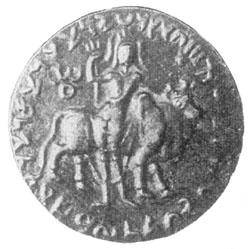 |
|
Kushan
coins dated around 2nd century A.D. with Shaivite images
|
By the Christian era, Shiva had captured popular imagination. He was no longer restricted to the austere Pashupatas whose doctrines were propounded by Lakulisha (200 A.D.) or to renegade antinomial cults like the Kapalika, Kalmukha, Kanphata and Aghora. Shiva's worship ceased to be just tribal or occultic. In India it became part of the mainstream, manifesting itself in various forms from Kashmir in the north to Kanyakumari in the south.
As Buddhism faded away from Indian society, many of its doctrines managed to survive within the emerging Shaivite orders. Kings like the Kushans, Guptas, Pandyas and Cholas began accepting Shiva's spiritual overlordship.
They appreciated his colourful personality. Shaivite emblems like the bull and the peacock began appearing on their coins. They also began building great temples to house Shiva's greatest symbol: the linga.
The earliest evidence of linga worship comes from the first century B.C. thought the practice can be traced to the Indus valley cities, and to aboriginal cultures before that. By the classical Age (400 A.D.) the practice had become widespread. It was an easier, more accessible route to commune with the divine. It seemed a more meaningful alternative to exotic fire-sacrifice and erudite philosophies. The pillar shaped linga was the simplest form conceivable and perhaps the earliest physical representation of god. At first, the orthodox priests despised the non-Vedic worship of phallic symbols. When they finally reconciled to this very earthy icon, they did so by giving it numerous socially acceptable metaphors. The Agamas were written to explain the worship of Shiva in detail, right from construction of the shrine to consecration of the idol. These soon became as important as the Vedas.